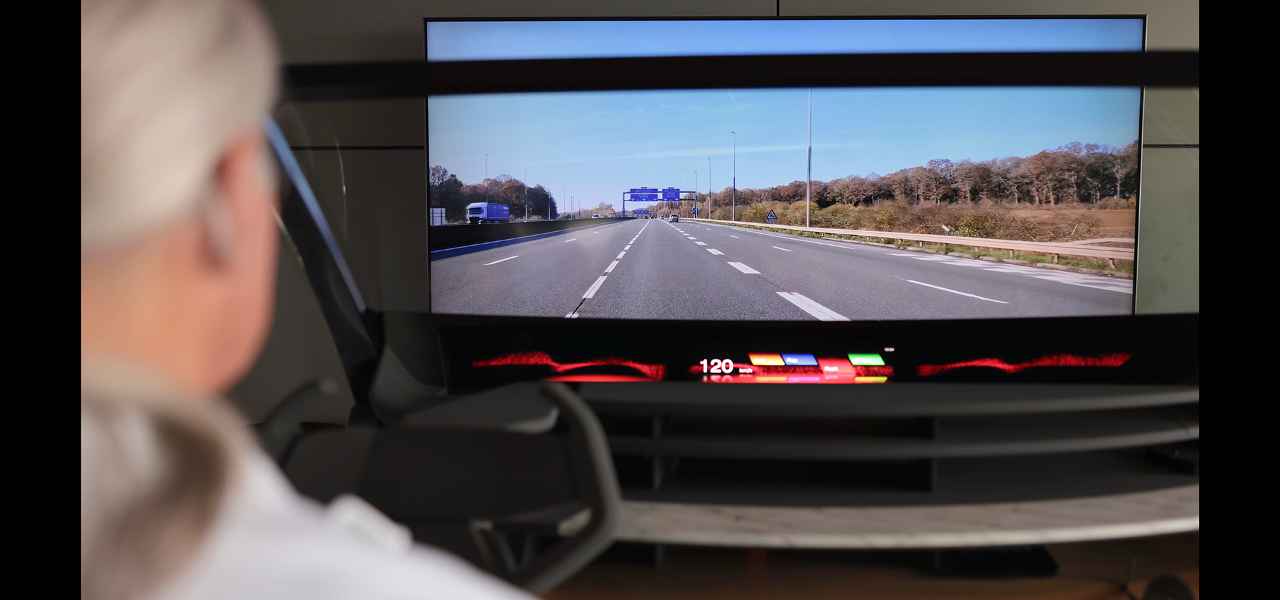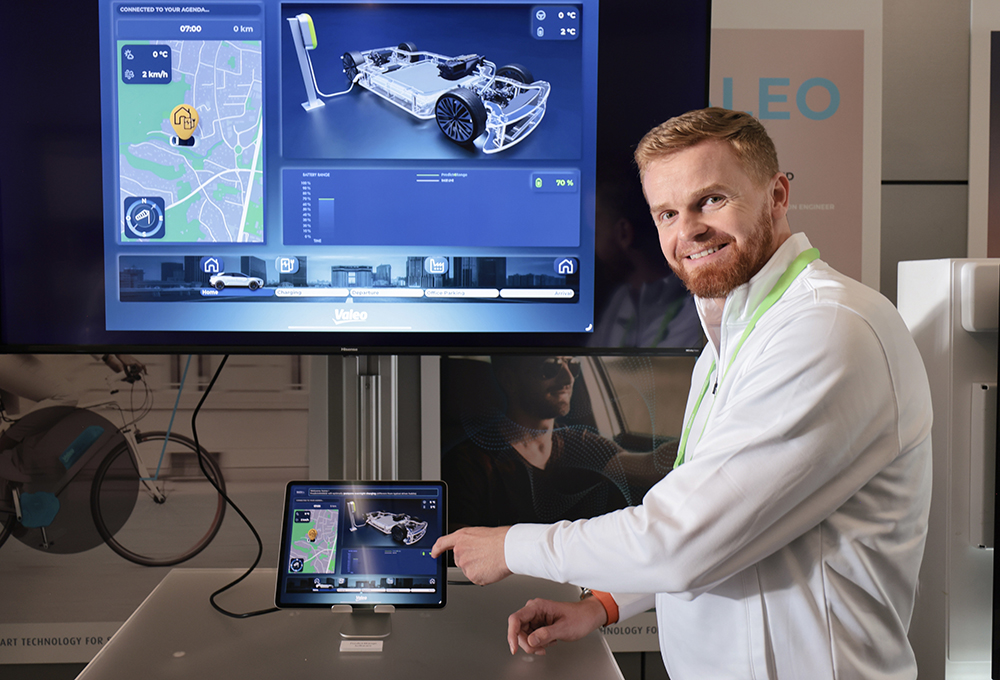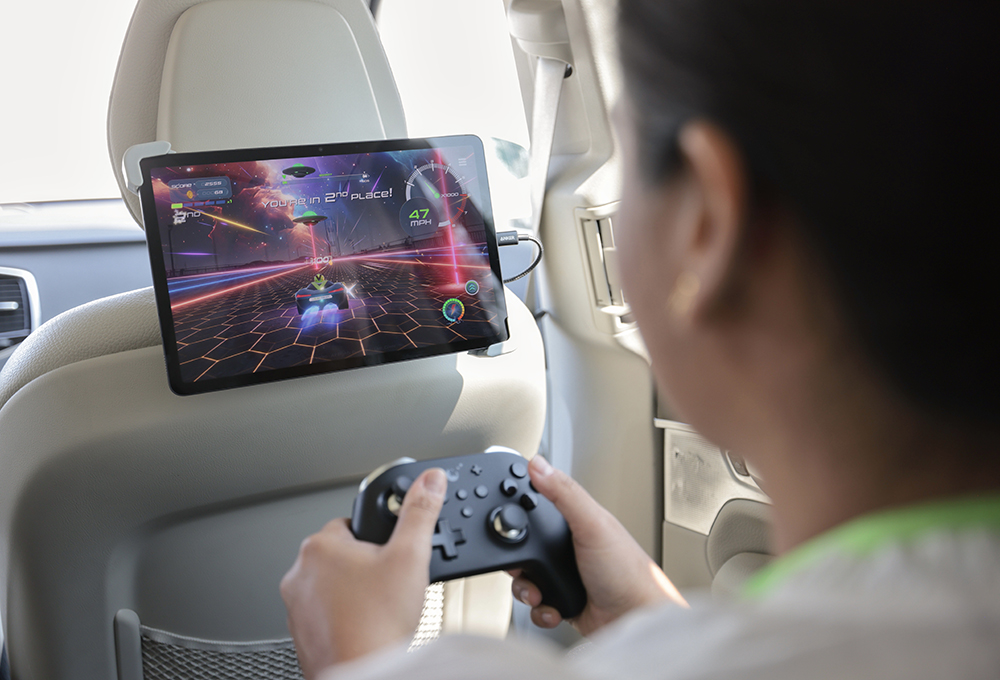 法雷奥的Gus McDonald正坐在Panovision创新解决方案的示范平台上。(法雷奥)
法雷奥的Gus McDonald正坐在Panovision创新解决方案的示范平台上。(法雷奥) 法雷奥的Jeffrey Shay指出,中国的电气化进程比其他国家更快。"Shay 说:“我们正在利用这一优势,帮助我们的客户实现转型。”(法雷奥)
法雷奥的Jeffrey Shay指出,中国的电气化进程比其他国家更快。"Shay 说:“我们正在利用这一优势,帮助我们的客户实现转型。”(法雷奥) Jonathan Rost与6合1设备(法雷奥)
Jonathan Rost与6合1设备(法雷奥) 法雷奥的Dominik Sporna谈到了在电动车通勤前预调电池的价值。(法雷奥)
法雷奥的Dominik Sporna谈到了在电动车通勤前预调电池的价值。(法雷奥)
法雷奥是一家拥有101年历史的全球汽车零部件供应商,其技术专家向我们详细介绍了位于密歇根州特洛伊的北美总部目前正在生产和研发的多款产品和技术。本文介绍了其中的部分技术亮点。
信息娱乐数据呈现在距离驾驶员4.9英尺(1.5m)的前方。McDonald表示:“这一距离是由光线反射到驾驶员眼睛的光路长度决定的。”在研发Panovision的过程中,如何编写软件代码以控制数字显示屏中288个区域的调光,以及如何集成背光功能是法雷奥工程师重点解决的两项关键任务。McDonald称:“法雷奥LED散热片专利技术能够有效散热,最大限度地减少了对持续主动冷却的需求。”目前,法雷奥的Panovision显示设备尚未投产。
这套6合1智能电驱系统不要求额外安装冷却水循环管道或大型散热器进行冷却。Rost称:“我们采用内置油冷系统,其中的电动油泵可将机油泵送至电机、变速箱和电力电子设备中。该系统具备完整的冷却功能,可利用空气辅助冷却,无需安装额外设备。”因为电机和变速箱共用机油,所以冷却液的流经路径需要设计成合适的形状,“以避免机油受到污染并损坏组件。”Rost指出。
6合1 eDrive系统的输出功率为80kW。Rost称:“我们目前正在测试各组件的连续输出功率。目前为止,测试结果比仿真结果更为理想。”该系统计划于2026年开始生产,并首次应用于一家中国汽车制造商的小型电动车。据Rost介绍,这套动力系统还可用作辅助电动车桥。Roast表示:“辅助车桥的功率一般较低,且在全驱汽车中的使用频率也较低。因此,全驱汽车有时也可断开辅助车桥,以节省旋转阻力造成的电池电量损耗。
根据法雷奥动能系统事业部首席工程师Dominik Sporna介绍,除了编写控制电动车不同热模式的软件代码外,法雷奥工程师还开发了专用算法,从而在有效管理电池并维持最佳车内舒适度的情况下,尽可能提高电动车在日常通勤中的能效。预先调整电池状态是提高能效的一种途径。Sporna解释说:“预先调整电池状态就是指在充电时留出一部分电量,并在出发前充满。”他指出,这种方法可减少通勤期间使用的电量。
软件算法可通过分析出发日期、天气条件、交通状况等信息来预先设定电池和座舱状态。这种做法在极寒或极热天气出行时尤其必要。法雷奥全新热管理算法Predict4Range目前正处于概念验证阶段。Sporna 称:“Predict4Rang算法是法雷奥标准软件的附加功能,可进一步提升电池热管理系统的效率。相较于传统控制系统,这套算法可延长24%的续航里程。”
Valeo Racer有望成为首款利用车辆周围环境的实时画面制作的电子游戏,并可让乘客在车辆行驶过程中畅玩。游戏开发者Anthony Amos表示:“我们正从高级驾驶辅助系统(ADAS)传感器、法雷奥摄像头以及机器学习算法中提取数据,并将其整合到游戏中。我们能够将实时视频数据和真实世界的感知数据实时传输到游戏中。”
法雷奥以静态或动态的方式向我们展示了数十款产品。Shay表示:“我们都认识到汽车行业正在经历重大变革。公司的战略非常明确,那就是在支持汽车电气化转型的同时,尽可能在我们的业务范围内保持开放的态度,以支持整个行业的发展。”
New hardware and software code prepped for inside-out vehicle makeovers.
Whether it’s reinventing the vehicle cabin, repackaging power products, or writing new software code, Valeo is focused on smarter mobility technologies. “When you put it all together, you see that the building blocks are there to not only support the electrification transformation but actually to accelerate the transformation,” Valeo North America’s President Jeffrey Shay told SAE Media at the company’s recent Innovation Days event in September.
Technology specialists from the 101-year-old global supplier gave details on several in-production products and in-development technologies at the firm’s North American headquarters in Troy, Michigan. Here are a few highlights.
Immersive display
Valeo’s Panovision is a pillar-to-pillar infotainment and navigation immersive display comprised of three 15.9-in (404 mm), liquid crystal display screens. The three panels, which seamlessly appear as one in-dashboard screen, are illuminated from the backside. “There are no optics creating the projection, it’s just the mechanical location of the panels and a black stripe on the windscreen that’s coated to enhance the reflectivity,” said Valeo senior technology opto-electronics expert Gus McDonald. Typical windscreen reflectivity, McDonald said, is 15-20% compared to the Panovision’s 40% reflectivity.
Infotainment data appears to float approximately 4.9 ft (1.5 m) in front of the driver. “That distance is due to the optical path length of the reflection to the driver,” McDonald said. Panovision’s software code for controlling the dimming of the digital display’s 288 zones as well as how the backlight function is packaged were key tasks handled by Valeo engineers. “Valeo’s patented method of LED heat sink dissipates heat efficiently, minimizing the need for continuous active cooling,” McDonald said. Valeo’s Panovision is not yet in production.
Bundled power package
Valeo’s Smart eDrive 6-in-1 plug-and-play unit is three steps beyond today’s state-of-the-art 3-in-1 system that features a motor, gearbox, and inverter. The 6-in-1 power package adds an onboard charger, DC-DC converter, and power distribution unit. “By adding those electronics, we’re able to reduce the packaging and weight by approximately 15%,” said Jonathan Rost, customer chief engineer for the Valeo Power Division.
The 6-in-1 unit doesn’t require additional water lines or a larger radiator to cool it. “We have an internal oil cooling system, so there’s an electric oil pump that pumps oil through the motor, the gearbox and the power electronics. It’s all self-contained, and it’s cooled by the air,” Rost said. Because the motor and the gearbox share the same oil, appropriate flow geometry for the cooling fluid’s path was necessary “to make sure that the oil doesn’t become contaminated and then damage something,” Rost said.
Power output for the 6-in-1 eDrive is 80 kW. “We’re testing parts now for continuous power output, and so far, the result is more favorable than what was shown with simulations,” Rost said. The eDrive unit is slated to start production in 2026 for the first vehicle application, a Chinese automaker’s small electric car. According to Rost, the power unit could also be used as a secondary e-axle. “The secondary axle usually has less power and is used less often for all-wheel drive. It’s also sometimes possible to disconnect the secondary axle to save on battery electricity due to rotating drag losses,” Rost said.
Battery charging schedule
In addition to writing software code to control different electric vehicle thermal modes, Valeo engineers are developing algorithms to help maximize the energy efficiency of an electrified vehicle during a daily commute while maintaining optimal battery and cabin conditions, according to Dominik Sporna, chief engineer for the Valeo Power Division. One source of energy optimization is via pre-conditioning the battery. “We want to charge the battery but still leave a percentage of the charge to be done just before departure,” said Sporna, noting that pre-conditioning the battery can reduce the amount of energy used during a commute.
By taking into account information about the departure date, weather conditions, traffic and other factors, software algorithms become a conduit to the pre-conditioning of the battery and the vehicle cabin. This is especially relevant for travel on intensely cold or hot days. Valeo’s new thermal management algorithm, referred to as Predict4Range, is currently in the proof-of-concept stage. “This is an additional feature for our standard software, boosting even further the efficiency of the battery’s thermal management system, offering an up to 24% range increase compared to traditional control systems,” Sporna said.
Gaming on the road
Valeo Racer is expected to be the first video game to use live images of the vehicle’s surroundings and can be played while the vehicle is in motion. “We’re pulling in the data from ADAS (advanced driver assist system) sensors, Valeo cameras, and machine learning algorithms and incorporating that for game play. We’re able to stream real-time video data and real-world perception data to the game itself,” said Anthony Amos, the game’s developer.
SAE Media played Valeo Racer during a vehicle demonstration drive on a two-lane boulevard that included other motorists, traffic lights, and buildings. Played on a mobile device, players drove a race car along the same route as the demonstrator vehicle to collect gold coins and try to avoid hovering tires. “A lot of in-vehicle gaming systems are limited to treating the infotainment system as a gaming console while the vehicle is parked. With this system, passengers can enjoy the game during the drive,” Amos said. The game, which won’t be sold directly to consumers by Valeo, could debut in a production vehicle as early as 2025.
Dozens of Valeo products were shown as either static or dynamic displays. “We all recognize that the automotive industry is going through a significant transformation. Our strategy is, very simply, to support the electrification transformation while being as agnostic as we can with as much of our business as we can to support the whole industry,” Shay said.
等级
打分
- 2分
- 4分
- 6分
- 8分
- 10分
平均分
